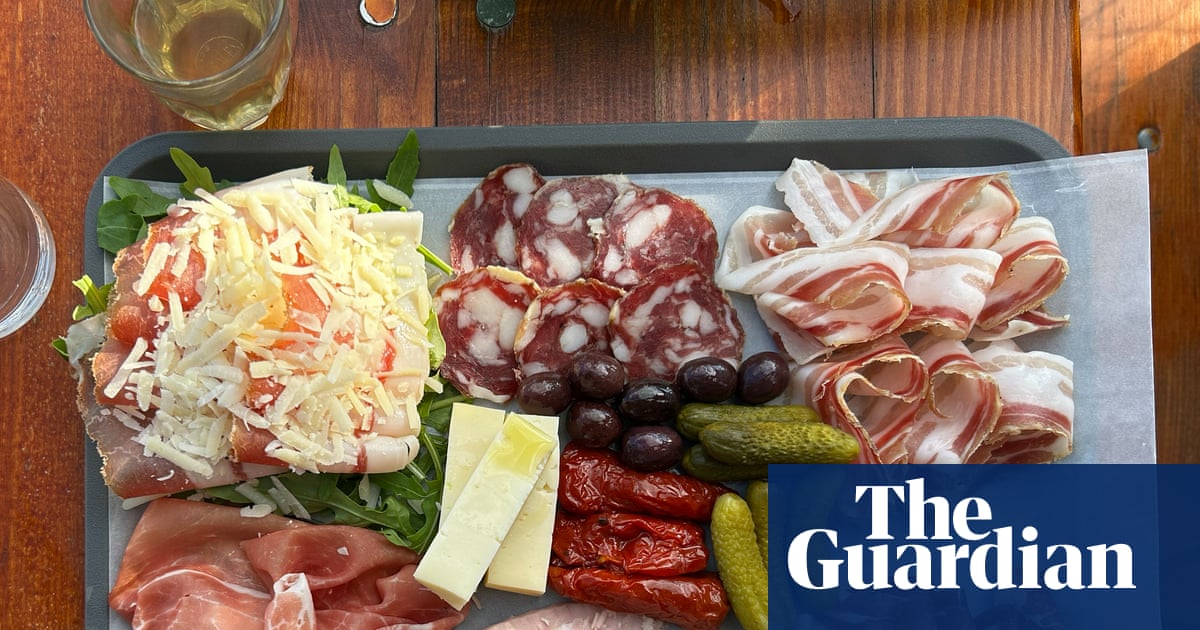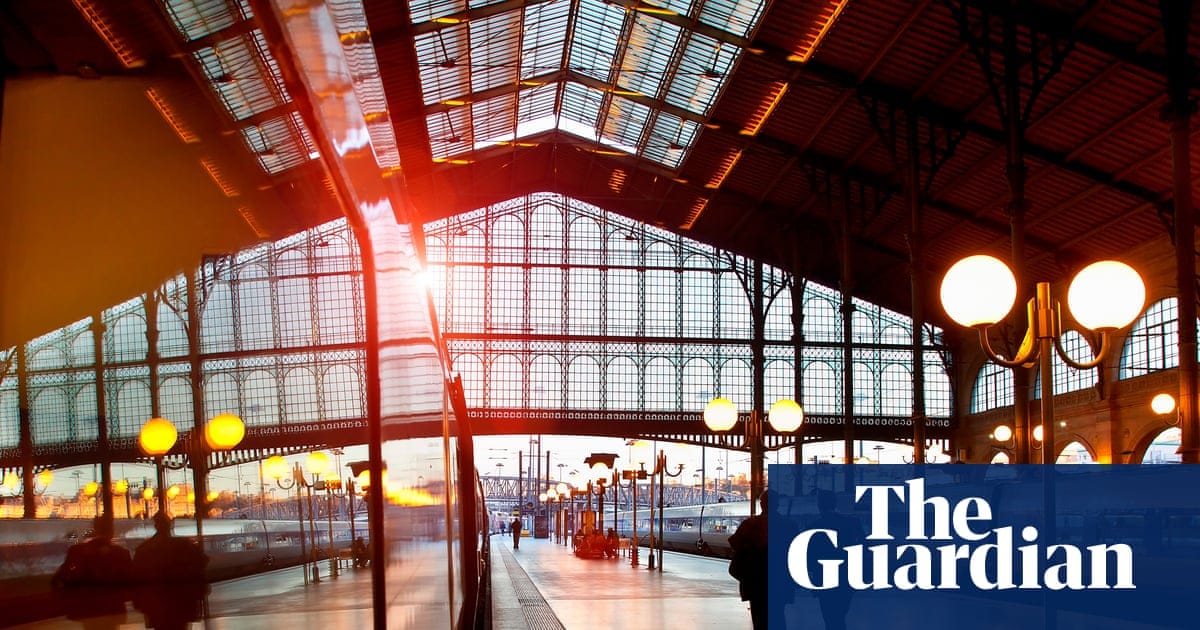A place at the farmer’s table on a foodie trip to Trieste | Food and drink
In Trieste and the Meaning of Nowhere, travel writer Jan Morris described the city’s many faces and “ambivalence”, maintaining that, unlike most other Italian cities, it has “no unmistakable cuisine”. But I had come to Trieste to experience, if not a cuisine, then a culinary tradition which, to me at least, does seem unmistakable: the osmiza scene of the surrounding countryside.
An osmiza (or osmize in the plural) is a Slovene term for a smallholding that produces wine in the Karst Plateau, a steep rocky ridge scattered with pine and a patchwork of vineyards that overlooks the Adriatic Sea. Visiting osmize is a centuries-old tradition in which these homesteads open their doors to the public for a fleeting period each year. Guests order their food and wine at a till inside – where a simply tiled bar, often set into local stone, might boast family photos, halogen lights and a chalkboard menu – before heading outside to feast at long Oktoberfest-style tables and benches.
“On the Italian side of the border, we just serve cold food,” Jacob Zidarich tells us, as he places down plates of pickled courgette, house-cured salumi, local cow’s milk cheese and a homemade sausage with mustard and grated horseradish. “But in Slovenia, you find cooked food.”
I am sitting with my partner on the hot terrace at Zidarich’s family home, looking out over a glittering Adriatic. To accompany our food, Zidarich pours two glasses of liquid gold vitovska, a white wine indigenous to this corner of Friuli-Venezia-Giulia, the north-eastern Italian region that borders Slovenia, and which is home to the port city of Trieste.
To understand the tradition of visiting osmize is to grasp something of Trieste’s complex history and multifaceted cultural identity. The word derives from the Slovenian osem, meaning “eight”, a reference to a decree by 18th-century Holy Roman empress Maria Theresa that farmers in the Karst could sell their wares for eight consecutive days each year.
The result is an enduring tradition in which farmers only open for a short time each season, although almost all of them are now open for more than eight days a year. For this reason, no two osmiza-based itineraries are the same. Turn up at virtually any time of year and there will be osmize open – especially over the warmer months – all offering an affordable flavour of the Friulian countryside.
You’ll pay little more than €2-3 for a quarter-litre carafe of wine and €12-15 for an abundant platter of cold cuts, pickles and pillowy white bread. The tradition is particular to this tiny nook of Friuli, although as Zidarich indicated, it also exists – with differences – over the Slovenian border. Our focus is the Italian side where you can check which osmize are open (on the day of writing, there are 13) and at what time on the website osmize.com.
I base myself at the charming Hotel Albero Nascosto in the centre of Trieste for three nights and, with the intention of visiting as many of the osmize as possible, hire a car. I make it to four osmize, and realise quickly that Zidarich is something of an exception. Although his family had been making simple white and red wines for generations, it was his father, Benjamin, who transformed the farm into one of the most respected wine producers in the region. At other osmize we mostly drink wine from kegs. Some might describe these places as rustic, but even the table wines here have a clear style and moreish complexity to them.
Next up is Verginella Dean, an osmiza bustling with both locals and visitors and known for its peerless view of the Gulf of Trieste. From here the city’s Piazza Unità d’Italia is just visible, as is the brutalist Temple of Monte Grisa (which we visit afterwards). From an outdoor bar with two wine taps, I order a quarter of malvasia for two of us and a mixed platter of pork cuts, triangles of salty cheese and sun-dried tomatoes “for one” (it could feed four).
Osmize aren’t so much a cuisine as a gastronomic tradition, but I might have put to Jan Morris that they are emblematic of a place that, although bureaucratically Italian, has strong Slovenian influences. Zidarich’s vineyards straddle the border with most of the land being in Italy, but Slovenian is the language spoken at home, as with all the farmers I met.
after newsletter promotion
“We don’t feel Italian here, we feel like we’re from Trieste,” says Theresa Sandalj, who owns a green coffee import business based in the city. The daughter of Trieste Slovenians, she tells me she grew up without any Italian traditions – “no lasagne, no ravioli” – and that when she met her Milanese husband she gave him a copy of Morris’s book “to explain what I was”.
Trieste, then, is at a crossroads between three great European cultures: Roman, Slavic and Austrian. But it doesn’t stop there – it’s a multi-faith, “inter-racial jumble”, as Morris had it, home to one of the largest synagogues in Europe alongside Greek and Serbian Orthodox churches. Its significant immigrant communities rub shoulders.
Besides osmize, there are plenty of reasons for hungry travellers to visit Trieste, from its quirky coffee culture complete with its own vocabulary (here an espresso is a nero, which could refer to a glass of red wine elsewhere in the region) to fresh fish and seafood at restaurants such as Trattoria Nerodiseppia and Le Barettine, which are both within spitting distance of the hotel.
We also loved Mimì e Cocotte, a centrally located seasonal restaurant that combines the humility of home-cooked food with a sense of occasion, and specialises in regional natural wines. With these we wash down courgette frittata and two plates of pasta – cacio e pepe, and cavatelli with tomatoes and stracciatella. Just outside Trieste, in the seaside village of Duino, Alla Dama Bianca has the fading charm of a 1970s hotspot. Here we eat razor clams and watch swans glide across the water as the sun sets.
Back in Trieste, on Via Giusto Muratti, we discover Pagna, an artisanal bakery and natural wine bar run by the Serbian pastry chef Pedja Kostic, who was drawn to Trieste from Belgrade via the US, by the wine scene. At Pagna I eat the almond croissant of my life: a perfect crisp pastry with a pillowy interior hugging not-too-much frangipane.
But it was for osmize that I came, where each one reflects the people behind it. At Šuc Erika, an osmiza in the middle of a farmyard, whose walls are adorned with a picture depicting ricotta production and felt-tip drawings by previous child guests, we order from a woman in a Metallica T-shirt. Afterwards, we sit under a pergola of ripening grapes. Rather magically, we are the only ones here, and sip our drinks (which, unusually, include a delicious cloudy beer brewed in-house) to a soundtrack of cattle lowing and stamping their hooves.
Unable to resist just one more before we leave, we head to Osmiza Boris in Medeazza, where Boris’s wife, Patricia, is behind the bar. She tells us about the salumi, wine vinegars, olive oil and honey they make on-site, while two teenage sons pad in and out of a courtyard in flip-flops. Boris was recommended to us by a waiter at La Dama Bianca as one of his favourites to visit before work, which gives you some indication of how widely enjoyed osmize are here – democratic and available to everybody, when they happen to be open.
The trip was provided by Promo Turismo FVG, the tourist board of Friuli-Venezia-Giulia. Doubles at Hotel Albero Nascosto from £120 B&B



